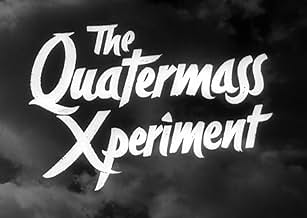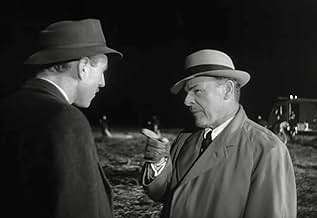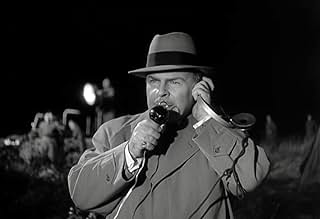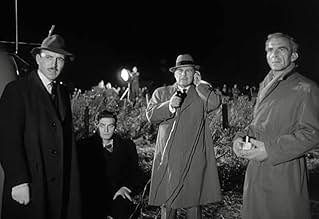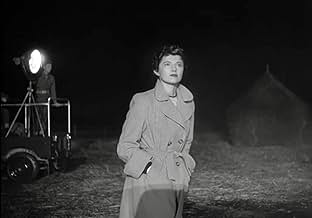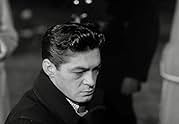AVALIAÇÃO DA IMDb
6,6/10
8 mil
SUA AVALIAÇÃO
O foguete tripulado do professor Bernard Quatermass retorna à Terra, mas dois dos astronautas estão desaparecidos e o sobrevivente parece doente e incapaz de se comunicar.O foguete tripulado do professor Bernard Quatermass retorna à Terra, mas dois dos astronautas estão desaparecidos e o sobrevivente parece doente e incapaz de se comunicar.O foguete tripulado do professor Bernard Quatermass retorna à Terra, mas dois dos astronautas estão desaparecidos e o sobrevivente parece doente e incapaz de se comunicar.
- Direção
- Roteiristas
- Artistas
Jane Aird
- Mrs. Lomax
- (não creditado)
Margaret Anderson
- Maggie
- (não creditado)
Jane Asher
- Little Girl
- (não creditado)
Harry Brunning
- Night Porter
- (não creditado)
Ken Buckle
- Police Driver
- (não creditado)
Eric Corrie
- Maggie's Boyfriend
- (não creditado)
Edward Dane
- Station Policeman
- (não creditado)
Gron Davies
- Charles Green
- (não creditado)
- Direção
- Roteiristas
- Elenco e equipe completos
- Produção, bilheteria e muito mais no IMDbPro
Avaliações em destaque
POSSIBLE SPOILERS Government scientist Professor Bernard Quatermass (BRIAN DONLEVY) sends a rocket into space containing three astronauts. Radio contact is lost and later it crash lands in the English countryside. Two of the crew members are missing, but the survivor, Victor Carroon (RICHARD WORDSWORTH) is slowly being taken over by an alien fungus that feeds on the blood of animals and human-beings.
In a bid to win audiences away from their TV sets (something that was a real threat to cinemas at the time), Hammer elected to film the popular BBC serial THE QUATERMASS EXPERIMENT (the E was replaced with X in order to emphasise it's X certificate), which was the creation of writer Nigel Kneale. The gamble payed off and Hammer had a box office hit on their hands in 1955.
Seen today, THE QUATERMASS XPERIMENT is obviously very tame in comparison to modern day sci-fi and horror films, most of it's shock sequences occur off screen with the camera cutting away and harping back on reaction shots. Yet it is a milestone in the development of British horror cinema and along with the company's THE CURSE OF FRANKENSTEIN, it spawned this country's horror boom of the 1950's and 60's. Richard Wordsworth's Carroon is one of the most sympathetic monsters in British horror and there is a classic scene at the London docks where the former is hiding out in an abandoned boat and is awakened by a little girl who is having a pretend picnic with her dolly. Unaware of the true horror that's going on, the little girl naively asks Carroon if he wants to join them. One can see that Carroon is fully aware of what would happen if the girl touches him and runs away accidentally breaking her dolly.
Wordsworth is brilliant as Carroon and so is Brian Donlevy as Quatermass while director Val Guest's documentary approach gives the picture a sense of conviction.
In a bid to win audiences away from their TV sets (something that was a real threat to cinemas at the time), Hammer elected to film the popular BBC serial THE QUATERMASS EXPERIMENT (the E was replaced with X in order to emphasise it's X certificate), which was the creation of writer Nigel Kneale. The gamble payed off and Hammer had a box office hit on their hands in 1955.
Seen today, THE QUATERMASS XPERIMENT is obviously very tame in comparison to modern day sci-fi and horror films, most of it's shock sequences occur off screen with the camera cutting away and harping back on reaction shots. Yet it is a milestone in the development of British horror cinema and along with the company's THE CURSE OF FRANKENSTEIN, it spawned this country's horror boom of the 1950's and 60's. Richard Wordsworth's Carroon is one of the most sympathetic monsters in British horror and there is a classic scene at the London docks where the former is hiding out in an abandoned boat and is awakened by a little girl who is having a pretend picnic with her dolly. Unaware of the true horror that's going on, the little girl naively asks Carroon if he wants to join them. One can see that Carroon is fully aware of what would happen if the girl touches him and runs away accidentally breaking her dolly.
Wordsworth is brilliant as Carroon and so is Brian Donlevy as Quatermass while director Val Guest's documentary approach gives the picture a sense of conviction.
The Quatermass series both inspired and paved the way for many sci-fi greats that would follow it, from shows such as 'Doctor Who' to 'Alien'. Indeed both of these examples successfully blended horror with sci-fi just as Quatermass did right in its very first outing - 'The Quatermass Experiment'. The horror element no doubt also inspired Hammer Films to do this remake only two years after the original series, and they do it well.
Pre-dating Gagarin's successful trip into space, the story involves the first successfully-manned rocket returning from its maiden voyage. The program is headed by professor Bernard Quatermass of the British Rocket Group - a man extremely determined to push the frontiers of science - even if it means sacrificing lives. There's more than a touch of Jules Verne's science-is-the-beginning-and-the-ending about this man. Unfortunately, upon the rocket's return, where there were once three men there is now but one. To top it off, he doesn't seem to be feeling especially well - and it isn't travel sickness.
In 'Xperiment', Quatermass is portrayed by American Brian Donlevy, no doubt to broaden the film's potential market. Donlevy gives his version absolute conviction - this is a man who will not be stopped by any setbacks, convinced as he is that humans must become an interplanetary species. We really need people like him today. Other well-known actors of the day round out the strong cast, but I'd also like to give special mention to Richard Wordsworth, as the troubled sole-surviving astronaut Victor Caroon. Wordsworth could convey so much with just his face that he has presence without uttering a word.
The film also capitalises on the way space - particularly then, is a great unknown, where anything nice or nasty could happen simply by being there. As a result of the rocket's return, something wicked this way does come, and Hammer show their great skill not only in realising it effectively, but in creating wonderfully suspenseful moods in between. Doubtless the monochrome provides many more helpful dark shadows in this endeavour, but the production values really are more than good enough to convince even today.
So with a fascinating story by creator Nigel Kneale, well-chosen actors, and an excellent big-screen realisation, 'The Quatermass Xperiment' still shows why it pioneered what was to come. But more than that, it's still excellent in its own right.
Pre-dating Gagarin's successful trip into space, the story involves the first successfully-manned rocket returning from its maiden voyage. The program is headed by professor Bernard Quatermass of the British Rocket Group - a man extremely determined to push the frontiers of science - even if it means sacrificing lives. There's more than a touch of Jules Verne's science-is-the-beginning-and-the-ending about this man. Unfortunately, upon the rocket's return, where there were once three men there is now but one. To top it off, he doesn't seem to be feeling especially well - and it isn't travel sickness.
In 'Xperiment', Quatermass is portrayed by American Brian Donlevy, no doubt to broaden the film's potential market. Donlevy gives his version absolute conviction - this is a man who will not be stopped by any setbacks, convinced as he is that humans must become an interplanetary species. We really need people like him today. Other well-known actors of the day round out the strong cast, but I'd also like to give special mention to Richard Wordsworth, as the troubled sole-surviving astronaut Victor Caroon. Wordsworth could convey so much with just his face that he has presence without uttering a word.
The film also capitalises on the way space - particularly then, is a great unknown, where anything nice or nasty could happen simply by being there. As a result of the rocket's return, something wicked this way does come, and Hammer show their great skill not only in realising it effectively, but in creating wonderfully suspenseful moods in between. Doubtless the monochrome provides many more helpful dark shadows in this endeavour, but the production values really are more than good enough to convince even today.
So with a fascinating story by creator Nigel Kneale, well-chosen actors, and an excellent big-screen realisation, 'The Quatermass Xperiment' still shows why it pioneered what was to come. But more than that, it's still excellent in its own right.
A British spaceship returns to Earth but instead of celebrating this first space shot, there is a lot of confusion, as two of the three crew members are missing. Additionally, the one who DID return just doesn't look or act right and he's kept under supervision and monitored as his body seems to be undergoing some sort of metamorphosis.
This isn't exactly your standard 1950s sci-fi/monster film, as the story itself is more tightly written and seems more credible than the typical "bug-eyed monster" film. Instead of the over the top acting and silly special effects, this is a more cerebral style film and the "monster" doesn't even make an appearance until near the very end. Instead, the story slowly unfolds and at the same time, simple makeup does the trick--no ping pong ball eyes, giant killer lobsters or any of the sort of tripe seen in the sillier examples of the genre. About the only negative was the whole subplot of the wife trying to kidnap her husband away from the hospital--this didn't make a lot of sense. Still, overall it's a dandy sci-fi film and worth a look.
This isn't exactly your standard 1950s sci-fi/monster film, as the story itself is more tightly written and seems more credible than the typical "bug-eyed monster" film. Instead of the over the top acting and silly special effects, this is a more cerebral style film and the "monster" doesn't even make an appearance until near the very end. Instead, the story slowly unfolds and at the same time, simple makeup does the trick--no ping pong ball eyes, giant killer lobsters or any of the sort of tripe seen in the sillier examples of the genre. About the only negative was the whole subplot of the wife trying to kidnap her husband away from the hospital--this didn't make a lot of sense. Still, overall it's a dandy sci-fi film and worth a look.
In the countryside of London, a rocket crashes on a farm and Professor Bernard Quatermass (Brian Donlevy) and Scotland Yard Inspector Lomax (Jack Warner) arrive in the spot. The rocket was launched by Prof. Quatermass with the astronauts Victor Carroon (Richard Wordsworth), Greene and Reichebheim; however only Carroon is found very sick in the cabin. He is transported to a private clinic to stay under observation despite the protests of his wife Mrs. Judith Carroon (Margia Dean). She bribes a nurse to bring Carroon to her and she finds that he is transforming into a monster. Carroon escapes killing people and animals during his metamorphosis while the Scotland Yard is hunting him down and Dr. Quatermass discovers that his process is an alien invasion.
"The Quatermass Xperiment" is an early sci-fi from Hammer with a creepy alien invasion. Despite the low-budget, the screenplay is very well written and the film entertains, specially fans of sci-fi from the 50's. My vote is six.
Title (Brazil): "Terror que Mata" ("Terror that Kills")
Note: On 12 Dec 2019, I saw this film again.
"The Quatermass Xperiment" is an early sci-fi from Hammer with a creepy alien invasion. Despite the low-budget, the screenplay is very well written and the film entertains, specially fans of sci-fi from the 50's. My vote is six.
Title (Brazil): "Terror que Mata" ("Terror that Kills")
Note: On 12 Dec 2019, I saw this film again.
Unfortunately Nigel Kneal had absolutely no input into the film version of THE QUATERMASS EXPERIMENT . Out goes the philosophy and long discussions of the human condition and in comes the more formuliac and streamlined plotting of a hostile alien endangering the human race , but to be fair to Richard Landau he also jettisoned many underdeveloped subplots from the serial ( When episode one of TQE was broadcast on television Kneale was still writing episode 5 so some subplots were abandoned by Kneale in order to meet the deadline ) and - unlike film viewers in 2002 - the oft used premise of an alien entity coming back to Earth from a spaceship would still be very new to cinema audiences in the mid 50s. I might even be right in saying this is the first time this idea had appeared in cinema .
Director Val Guest treats THE QUATERMASS EXPERIMENT as SF film noir and brings in a heavy dose of mood and atmosphere especially during the night time zoo sequence. Unlike QUATERMASS 2 there`s no feeling that the night scenes were achieved by sticking a dark filter over the camera . Guest is less successful with his cast . Donlevy is relatively good at playing double crossing mobsters in the likes of THE BIG COMBO but he`s utterly unconvincing as a rocket scientist and it doesn`t help that he keeps pronouncing his name as " Qittermiss ", Margia Dean is utterly appalling as Judith Carroon , but Richard Wordsworth is outstanding as Victor Carroon even if he doesn`t have a single line of dialogue.
The BBC serial of THE QUATERMASS EXPERIMENT shocked the viewers of Britain when it was broadcast and in its own way the film version is almost as groundbreaking , it was a big hit at the UK box office which led to Hammer Films to concentrate solely on horror films something they would excell at for the next 10-15 years .
Trivia point 1 - The montage scenes of soldiers searching for Carroon at night time are actually culled from another British SF flick - SEVEN DAYS TO NOON
Trivia point 2- The last four episodes of the BBC serial were shown live on television but because of an industrial dispute they weren`t - unlike the first two episodes - recorded onto film which means no one will ever see the complete BBC QUATERMASS EXPERIMENT
Director Val Guest treats THE QUATERMASS EXPERIMENT as SF film noir and brings in a heavy dose of mood and atmosphere especially during the night time zoo sequence. Unlike QUATERMASS 2 there`s no feeling that the night scenes were achieved by sticking a dark filter over the camera . Guest is less successful with his cast . Donlevy is relatively good at playing double crossing mobsters in the likes of THE BIG COMBO but he`s utterly unconvincing as a rocket scientist and it doesn`t help that he keeps pronouncing his name as " Qittermiss ", Margia Dean is utterly appalling as Judith Carroon , but Richard Wordsworth is outstanding as Victor Carroon even if he doesn`t have a single line of dialogue.
The BBC serial of THE QUATERMASS EXPERIMENT shocked the viewers of Britain when it was broadcast and in its own way the film version is almost as groundbreaking , it was a big hit at the UK box office which led to Hammer Films to concentrate solely on horror films something they would excell at for the next 10-15 years .
Trivia point 1 - The montage scenes of soldiers searching for Carroon at night time are actually culled from another British SF flick - SEVEN DAYS TO NOON
Trivia point 2- The last four episodes of the BBC serial were shown live on television but because of an industrial dispute they weren`t - unlike the first two episodes - recorded onto film which means no one will ever see the complete BBC QUATERMASS EXPERIMENT
Você sabia?
- CuriosidadesThe film achieved notoriety Stateside when in 1956 the parents of Stewart Cohen attempted to sue Chicago's Lake Theater and distributors United Artists for negligence after their nine-year-old son died of a ruptured artery at a double-bill of this and A Torre dos Monstros (1956) on Sunday 28th October, during the opening sequence of the Hammer movie. Cohen entered the Guinness Book of Records as the only known case of someone literally dying of fright at a horror film (he had been unknowingly living with an undiagnosed heart condition): pathologist Dr Albert Baugher officially found that "The boy died of a heart collapse after extraordinary tension while watching a film."
- Erros de gravaçãoVolkswagen Bus en route to the crash site is not the same Volkswagen Bus that arrives through the gate at the crash site. VW badge is larger, chrome trim is missing and license plate is different.
- Citações
Prof. Bernard Quatermass: There's no room for personal feelings in science, Judith!
- Versões alternativasThe original 1955 "Quatermass Xperiment" print has the closing caption "The End"; the reissued version (with a still bearing the new title "The Quatermass Experiment" inserted into the opening credits) replaces this with "A Hammer Production Produced at Bray Studios".
- ConexõesFeatured in Frances Farmer Presents: The Creeping Unknown (1959)
Principais escolhas
Faça login para avaliar e ver a lista de recomendações personalizadas
- How long is The Quatermass Xperiment?Fornecido pela Alexa
Detalhes
- Data de lançamento
- País de origem
- Idioma
- Também conhecido como
- Projeto Quatermass
- Locações de filme
- East India Docks, London, Greater London, Inglaterra, Reino Unido(derelict boat scene with little girl)
- Empresa de produção
- Consulte mais créditos da empresa na IMDbPro
Bilheteria
- Orçamento
- £ 45.000 (estimativa)
- Tempo de duração
- 1 h 22 min(82 min)
- Cor
- Mixagem de som
- Proporção
- 1.37 : 1(original/negative aspect ratio, alternative theatrical ratio)
Contribua para esta página
Sugerir uma alteração ou adicionar conteúdo ausente



